Even if you love homebaked bread, you only sometimes have the schedule to make and bake a loaf, especially when it comes to sourdough. The solution is parbaked bread. You bake the bread until it’s almost finished, then freeze it. You can then take it out when you need it and finish baking. I’ll explain parbaking bread and give a recipe for a sourdough bread you can par-bake. The technique can be used for any bread, though.
Parbaking refers to baking the bread partially. Parbaking is quite an underutilized technique, but I will detail how you can make frozen bread come out freshly baked every time. You cannot tell the difference between the parbaked bread and one you’ve baked in one session.
It is not difficult at all, and it means that you can batch out bread and fill your freezer, and with a bit of planning, you can get freshly baked bread when you need it with minimal effort.
This article is not the place to start if you are new to sourdough bread. Instead, I’d recommend you look at my master recipe.
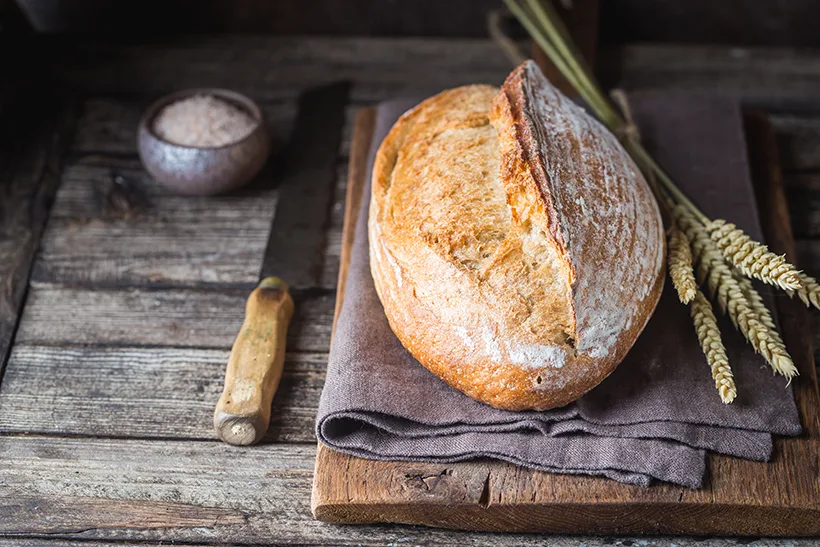
So what is the secret to parbaking bread?
So, for some reason, there’s not a lot of information about how to par-bake bread on the Internet, so I decided to perform my experiments on how to get the best par-baked that is indistinguishable from a freshly baked loaf.
Nothing here in this article is a secret. The commercial baking industry widely uses par-baking bread. In Denmark, supermarkets and gas stations have picked up bake-off, which has become wildly popular. Honestly, the results are pretty good and not far from what many bakeries produce.
So, there are a couple of steps to produce perfectly parbaked bread:
- Make your dough as you’d usually do. No changes here.
- If you are used to baking at 260°C/500°F for the first part of the bake, you’d probably want to lower the temperature to 230°C/450°F if baking in a dutch oven or 200°C/400°F if you are baking straight in the oven. The goal is to finish baking the bread with minimal browning.
- Bake until you hit an internal temperature of 90°C/194°F. That will ensure that the bread is completely baked but not browned yet.
- Let the bread come to room temperature, then freeze it in a ziplock bag. Air is the crux of stale bread. Try to remove as much air as possible.
- You have two options for browning the bread: thawing it or baking it directly from the freezer. If you want to serve the bread right away, you should thaw it first because the bread will still be very cold if you bake it frozen and will require some time to get to room temperature.
- I brown at 230°C/450°F, but you can go lower depending on the color you like on your crust. I will not give you a specific time, but I’d say in the ballpark of 15-30 minutes.
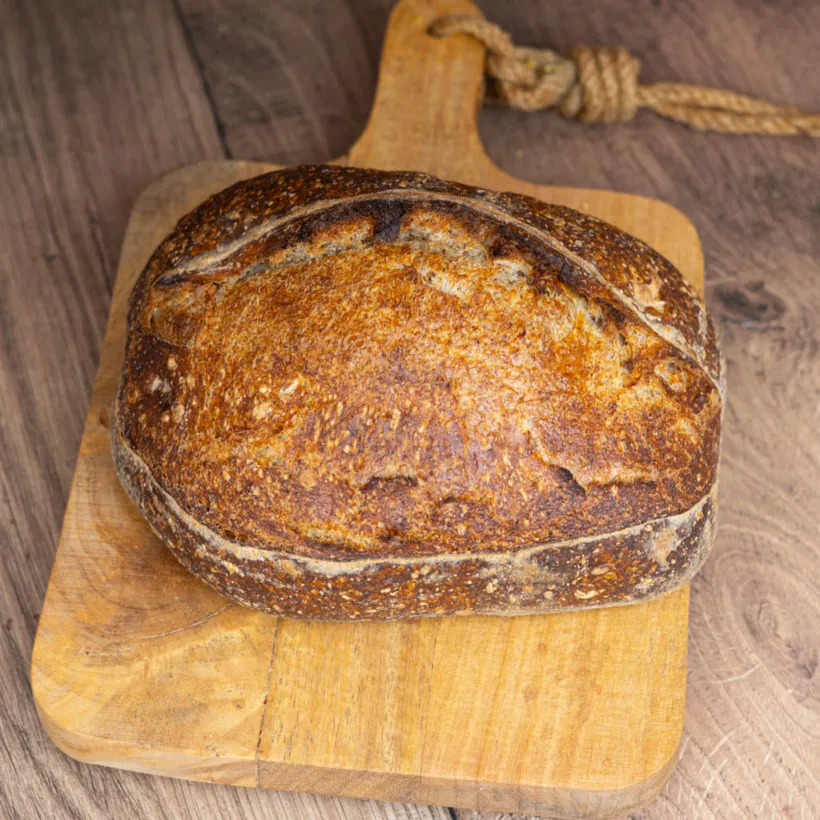
Why bake to 90°C/194°F?
When baking different things at certain temperatures:
| Temperature | Effect on bread |
|---|---|
| 60°C/140°F | The yeast dies |
| 70°C-80°C/158°F-176°F | The gluten coagulates, which means that the oven spring will end |
| 90°C/194°F | Gelatinization of the starches and the enzyme activity ends |
Can parbaking bread be used on any bread or baked good?
This technique will work on any baked good of the bread variety, be it bread, buns, or baguettes. You may have to shorten the browning phase; otherwise, the method stays the same.
I’ve yet to try it on cakes, but I don’t see why it would be impossible to develop a method for that. The temperatures would, of course, be completely different, but the principles would be the same. Well, there’s always an experiment for another day.

The dough in this recipe for parbaked bread
Vitals
| Total weight | 1400 grams |
| Pre-fermented flour | 9.1% |
| Hydration | 80% |
| Yield | 2 amazing sourdough loaves, finished out of the freezer |
The dough
The dough for this bread for parbaking is made from 80% bread flour and 20% rye flour. The hydration is 80%, and the salt content is 2%. The amount of sourdough starter is 20%.
| Weight | Ingredient | Baker's Percentage |
|---|---|---|
| 560g | bread flour | 80% |
| 140g | whole-grain flour | 20% |
| 546g | water | 78% |
| 140g | starter (100% hydration) | 20% |
| 14g | salt | 2% |
If you want to play around with the formula, change hydration, quantity, inoculation, or many other things, you can do that in my Bread Calculator.

Please share this article about parbaking bread on social media
This is my article about parbaking bread. If you like the article, please consider sharing it with like-minded bread lovers on social media.
If you make it and post it on Instagram, please tag me as @foodgeek.dk so I can see it. That would make me very happy.
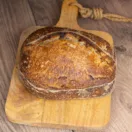
Par-baked Sourdough Bread
Equipment
Ingredients
Dough
- 560 g bread flour
- 140 g dark rye flour
- 546 g water
- 140 g starter fed and grown to its peak
- 14 g salt
Instructions
Make dough
- To a medium bowl, add bread flour, rye flour, and salt. Mix it with your hands.
- Then add the sourdough starter and water.
- Mix the dough so that all of the flour is hydrated. Then let the dough rest, covered, for an hour.
Bulk fermentation
- Then perform three sets of “stretch and folds” spaced out by 30 minutes. Once you’ve finished the stretch and folds, move the dough to a proofing container.
- Level the top. Mark where the top of the dough is and where your target rise is.
- If you’re proofing warm, your target rise should be 25%; if you’re proofing at room temperature, it should be 50%.
Divide and shape the dough
- Once the dough has grown, divide the dough into equally sized pieces.
- Using your scraper, pre-shape both doughs into balls. Let the balls rest for 20 minutes.
- Then shape both loaves into boules or batards. After you’ve shaped the loaves, put them into bannetons.
- Then put it in the fridge to retard, for at least 8 hours and up to 72 hours.
Bake the bread
- Heat your oven to 230°C/450°F with a dutch oven inside.
- Grab a loaf from the fridge. Dust the bottom with rice flour to help the loaf slide off the peel easily.
- Flip the loaf onto the peel, and score it. Then add it to the dutch oven, and bake for 20 minutes.
- Then prepare the second loaf. Move the first loaf out of the dutch oven to the side.
- Add the second loaf to the dutch oven and put on the lid. Bake for 10 minutes, then remove the first loaf from the oven.
- After 10 more minutes, remove the top of the dutch oven and finish the second loaf with 10 more minutes.
- If you prefer a lighter crust, you can bake with the lid on for 30 minutes instead of this method.
- Take the second loaf out, and let them both come to room temperature.
- Freeze each loaf in a ziplock bag for up to 3 months.
How to finish your loaf out of the freezer
- Heat your oven to 150°C/300°F. Once the oven is hot, add the frozen bread and let it heat for 10 minutes. We want the bread to thaw a little.
- Then heat the oven to 230°C/450°F. Brown the bread to your liking. I like mine dark, so I bake for about 20 minutes.
- Then take out the bread. Beware! The center of the bread is still frozen or at least very cold. Leave it to come up to temperature, or extend the thawing phase in the oven to 30 minutes if you need it faster.
How to finish your thawed loaf
- Heat your oven to 230°C/450°F. Then add the loaf, and bake until it’s to your liking. I find that 20 minutes work well for me.
- Then take it out of the oven. You can serve it right away. You already did the necessary cooling before you froze the loaf.
- That’s it. That’s how you par-bake bread.



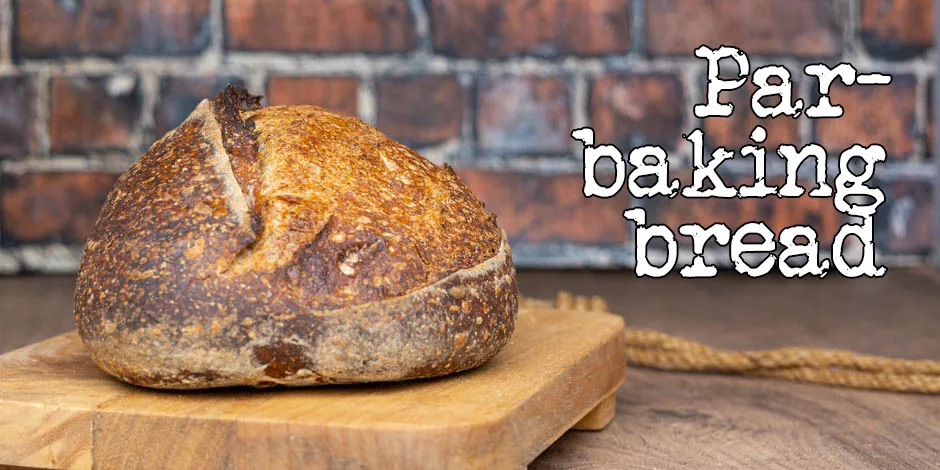

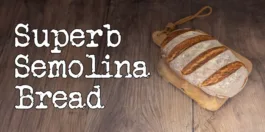
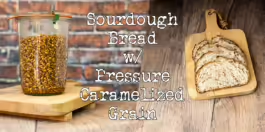


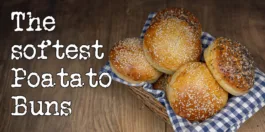

I’ve been lookiing for this for such a long time.
OK, just baked my parbaked loaf. I had it in the freezer and I let it thaw completely before baking. I am wondering if the 450° temp is too hot? Baked 10 minutes, bottom crust burnt and the top started to harden off, not in a good way.
Thank you for testing and sharing! I have a market coming up and was wondering how I was going to pull off same-day fresh baked bread… this will help! Question… do I have to freeze after par baking? meaning, can I par bake on one day, leave it to cool overnight on the wrack, and then finish the bake the next morning? Thoughts on that?